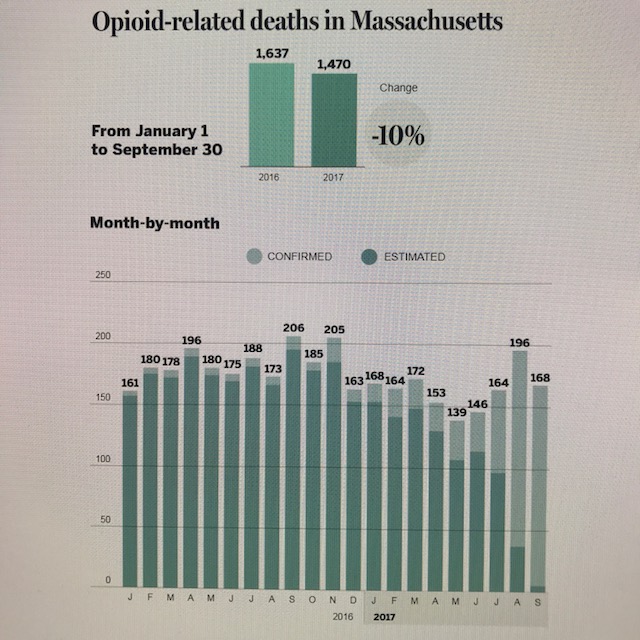BOSTON GLOBE, November 13, 2017
The number of people dying from opioid overdoses in Massachusetts dropped by 10 percent during the first nine months of this year, compared with the same period in 2016, according to new data that bolsters evidence the opioid crisis may be turning a corner.
But the state public health commissioner, Dr. Monica Bharel, said it’s still too soon to call the change a trend.
“We are seeing signs of progress,” Bharel said. “But we are still in the midst of an opioid epidemic.”
Still, the death toll remains high, with some 1,470 lives lost to opioid overdoses from January through September this year. Although lower than in 2016, the number of deaths is still much higher than in 2015 or any of the previous years.
Synthetic fentanyl sold illegally continues to be the leading factor in overdose deaths, with the drug found in eight out of 10 deaths for which a toxicology screen was performed. Prescription opioids were present only 16 percent of the time.
“This new report shows some trend lines that are moving in the right direction as we work to fight the opioid and heroin epidemic in Massachusetts,” Governor Charlie Baker said in a statement, “but there are still too many people dying from overdoses.’’
Additionally, it’s not known how many people are overdosing and surviving. The overdose-reversing drug naloxone, commonly known by the brand name Narcan, is now widely available in Massachusetts, deployed by first responders as well as friends and relatives.
He called the new data “reason for optimism,” but added, “Our members still see more demand for treatment than they can provide on a daily basis. We don’t see the demand for treatment diminishing in any way.”
Dr. Marc R. Larochelle, an internist and researcher at Boston Medical Center’s Grayken Center for Addiction, said the new data leave him “more optimistic than I was six months ago.” But he cautioned that numbers from only nine months are preliminary and could still spike upward.
The statewide efforts to address the crisis, along with growing awareness of the hazards of fentanyl, may be combining to “at least get us to the point where we are not seeing further increases,” Larochelle said. But there may have been a natural limit to how high the numbers could go, he added.
The number of people dying, he said, is “still staggeringly high.”
Dr. Jennifer Michaels, medical director of the Brien Center, a community mental health center in Pittsfield, called news of the 10 percent death-rate decrease “wonderful.”
She attributed it to wider availability of naloxone, which her center prescribes to every person who seeks treatment, and greater acceptance of medications that treat addiction — Suboxone, methadone and Vivitrol. “The medication is the most efficacious treatment. We’re making medication-assisted treatment more available,” Michaels said. Additionally, she said, the opening of new needle-exchange sites has helped draw more people into treatment.
But the Brien Center, which is Berkshire County’s largest provider of addiction services, is not seeing any decline in clients. “We have no shortage of patients,” Michaels said.
According to the state data, the estimated opioid-related overdose death rate increased by 21 percent in 2016 over the previous year, by 32 percent in 2015 compared with 2014, and by 40 percent in 2014 over 2013.
In the first six months of 2017, men age 25 to 34 were most likely to overdose. As in the past, three-quarters of overdose victims were male.
Hispanics remain disproportionately affected, accounting for 11 percent of opioid-related deaths but only 4 percent of all deaths. The opioid-related overdose death rate for Hispanics doubled from 2014 to 2016.
Felice J. Freyer can be reached at This email address is being protected from spambots. You need JavaScript enabled to view it.. Follow her on Twitter @felicejfreyer
The originally appeared in the Boston Globe on November 13, 2017.


